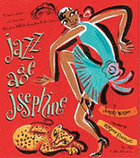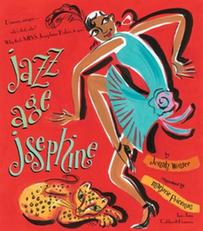
 Using the rhythm and pacing of blues lyrics, Jonah Winter (Diego) unspools the biography of dancer, singer, performer and activist Josephine Baker. Marjorie Priceman's (One of Each) loose line and expressive gouache-and-ink illustrations evoke the sensuality of the dances that rocketed Baker to the top.
Using the rhythm and pacing of blues lyrics, Jonah Winter (Diego) unspools the biography of dancer, singer, performer and activist Josephine Baker. Marjorie Priceman's (One of Each) loose line and expressive gouache-and-ink illustrations evoke the sensuality of the dances that rocketed Baker to the top.
Together they tackle some difficult moments in Baker's life in a way that picture book audiences can handle. They counter a sobering image of Josephine as a girl, huddled on the floor to sleep, "newspapers for a sheet--/ rats crawlin' all around,/ a nibblin' at her feet," with a picture of her Granny, on the opposite page, holding her and saying, "Someday you're gonna be a princess--/ you know what Granny says is true," as Priceman paints a fantasy tiara upon Josephine's head. Winter and Priceman portray Josephine's early dances (the "Turkey Trot" and the "Camel Walk"). The repetition of the blues lines, the elongated dance figures and the playful Art Deco type all contribute to a sense of her showmanship. A tragic event interrupts Josephine's impromptu performing on the night when "there were white folks chasin' black folks--/ on the black folks' side of town...." It's a reference to the East St. Louis riots of 1917, and Priceman, clearly portraying the threat to people's homes and persons, depicts the fire with an orange and red background and torches held by two white men, as Josephine and others flee to safety. Winter marks this as the pivotal moment when Baker decides to leave St. Louis: "So Josephine, she started runnin' too,/ she started runnin' on that night/..../ There had to be some better place/ where white folks treat you right." Priceman's stop-action, three-part sequence of her escape portrays a confidence that Josephine will find what she's searching for, and she does--in Paris.
Winter and Priceman skillfully connect Josephine's early animal dances with the costumes and choreography that wowed French audiences ("Panther, camel--/ who's that, who?/ Ostrich, parakeet--kangaroo?"). The author and artist's portrayal of Baker as someone who adheres to her beliefs from childhood, who has the strength as a 15-year-old showgirl in New York City to quit because she refuses to wear blackface, plants the seeds for her later work in the French Resistance and the U.S. civil rights movement (mentioned in an author's note). And in the finale, "dressed to the hilt," Josephine wears a tiara. You know what Granny says is true. Brava! --Jennifer M. Brown
Shelf Talker: This picture-book biography of Josephine Baker captures the performer's sensuality and convictions with a blues-like narrative and effervescent gouache-and-ink illustrations.

